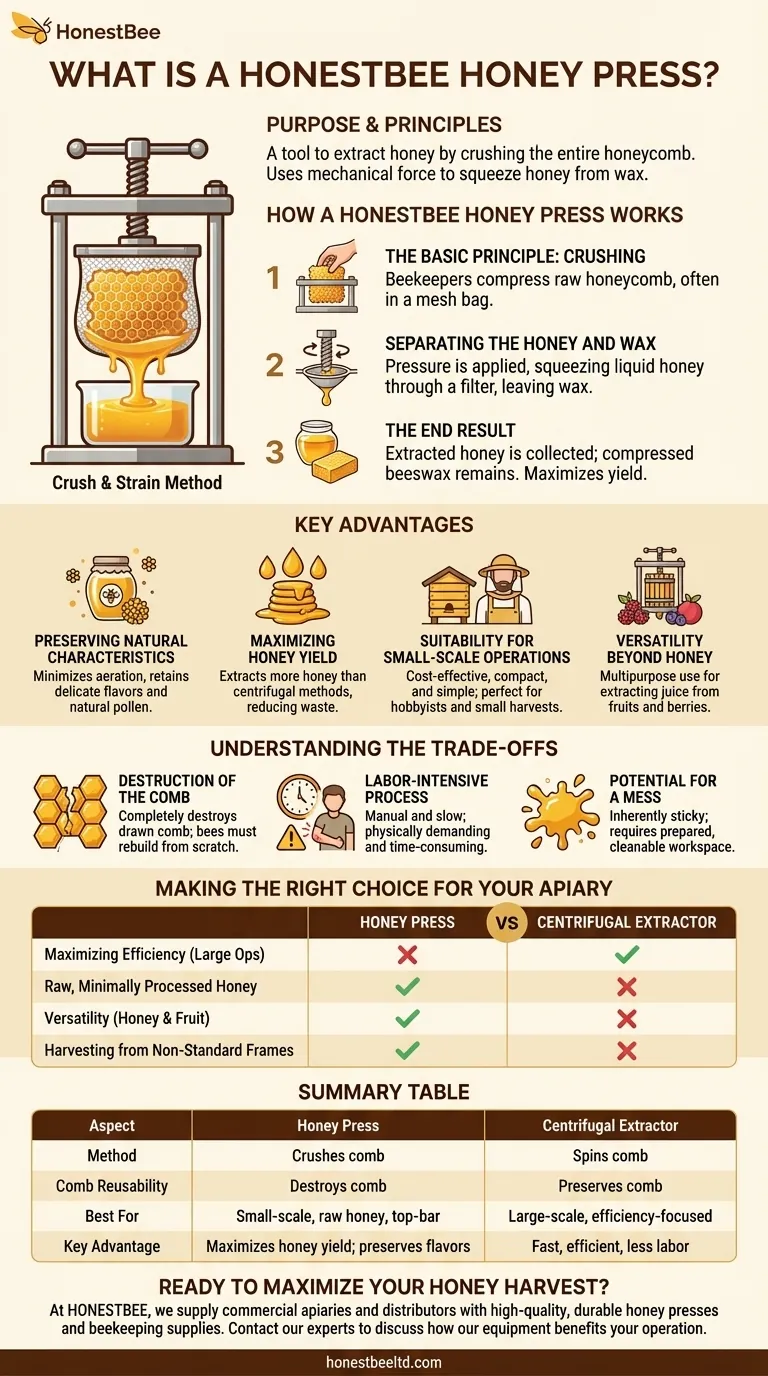In short, a honey press is a tool used to extract honey by crushing the entire honeycomb. Unlike centrifugal extractors that spin honey out of the comb, a press uses mechanical force to squeeze the honey from the wax, a method often called "crush and strain." This simple, effective process is particularly favored by small-scale beekeepers.
A honey press is a straightforward, often manual device chosen for its ability to maximize honey yield from a small harvest and preserve the honey's most natural characteristics. Its primary trade-off is the destruction of the honeycomb, which is a significant consideration for any beekeeper.

How a Honey Press Works
The principle behind a honey press is simple mechanical force. The process, while effective, is fundamentally different from using a spinning extractor.
The Basic Principle: Crushing
The core function is to compress raw honeycomb. Beekeepers cut the comb from the frames and place it inside the press, often within a mesh bag or cloth.
Separating the Honey and Wax
As pressure is applied, typically by turning a screw handle, the honey is squeezed out of the wax cells. The liquid honey drains through a filter or spout at the bottom of the press.
The End Result
The extracted honey is collected, while the compressed beeswax remains behind. This method captures nearly all the honey from the comb, resulting in very little waste.
Key Advantages of Using a Honey Press
While less common in large commercial operations, a press offers distinct benefits that make it the ideal choice in certain situations.
Preserving Natural Characteristics
Many believe that pressing, which avoids high-speed spinning and aeration, best preserves the delicate flavors and natural pollen content of the honey. This results in a product that is as close to its state in the hive as possible.
Maximizing Honey Yield
For a given amount of comb, a press is extremely efficient. It extracts more honey compared to some centrifugal methods, which can leave a thin layer behind in the cells. This makes it ideal for maximizing yields from smaller harvests.
Suitability for Small-Scale Operations
Honey presses are typically less expensive and more compact than centrifugal extractors. Their simplicity makes them perfect for hobbyists, beekeepers with only a few hives, or those just starting out.
Versatility Beyond Honey
A significant advantage is its multipurpose nature. The same press can often be used to extract juice from fruits and berries, adding value and utility to a small farm or homestead.
Understanding the Trade-offs
The benefits of a honey press come with important considerations. Objectively evaluating these trade-offs is critical.
Destruction of the Comb
This is the single biggest drawback. The press completely destroys the drawn honeycomb. The bees must then expend significant time and energy (and honey) to rebuild new comb from scratch. In contrast, centrifugal extractors leave the comb intact for reuse.
It's a Labor-Intensive Process
Pressing honey is a manual, and often slow, process. Cutting the comb, loading the press, applying pressure, and cleaning up can be physically demanding and time-consuming, especially compared to the speed of an electric extractor.
The Potential for a Mess
The "crush and strain" method is inherently sticky and messy. Managing the crushed comb and flowing honey requires a well-prepared and easily cleanable workspace.
Making the Right Choice for Your Apiary
To decide if a press is right for you, consider your primary goal.
- If your primary focus is maximizing efficiency and honey volume in a larger operation: A centrifugal extractor that preserves the comb is the superior choice, as it saves the bees significant work.
- If your primary focus is producing raw, minimally processed honey from a small number of hives: A honey press is an excellent, cost-effective tool that delivers a high-quality product.
- If your primary focus is versatility and you want a tool for both honey and fruit: A press offers outstanding value and functionality for a small homestead.
- If your primary focus is harvesting from comb without standard frames (like in a Warre or top-bar hive): The crush-and-strain method, for which a press is designed, is your necessary and most effective option.
Ultimately, choosing a honey press is a deliberate decision to prioritize honey quality and yield over comb preservation and speed.
Summary Table:
| Aspect | Honey Press | Centrifugal Extractor |
|---|---|---|
| Method | Crushes comb to squeeze out honey | Spins comb to fling out honey |
| Comb Reusability | Destroys the comb | Preserves the comb for reuse |
| Best For | Small-scale, raw honey, top-bar hives | Large-scale, efficiency-focused operations |
| Key Advantage | Maximizes honey yield; preserves natural flavors | Fast, efficient, and less labor-intensive |
Ready to maximize your honey harvest with the right equipment?
At HONESTBEE, we supply commercial apiaries and beekeeping equipment distributors with high-quality, durable honey presses and other essential beekeeping supplies. Our wholesale-focused operations ensure you get the reliable tools you need to produce superior honey efficiently.
Contact our experts today to discuss how our equipment can benefit your operation.
Visual Guide

Related Products
- Easy Use Manual Stainless Steel Honey Press for Honey Comb
- Electric Honey Press Machine for Squeezing Honey Comb Press Equipment
- Stainless Steel Manual Honey Press with Guard for Pressing Honey and Wax
- 10L Stainless Steel Electric Honey Press Machine
- Stainless Steel Honey Press Wax Press with Tank
People Also Ask
- How does a honey press work? A Guide to Simple, High-Yield Honey Extraction
- What are the two most popular types of machines for honey extraction? Choose the Right Tool for Your Apiary
- What are the recommended conditions for using a honey press? Achieve Optimal Honey Extraction
- What are the reasons for choosing a honey press over a dedicated honey extractor? Maximize Disease Control and Natural Beekeeping
- What are the steps to operate a bucket honey press? Maximize Your Honey Yield with Simple Mechanical Force



















